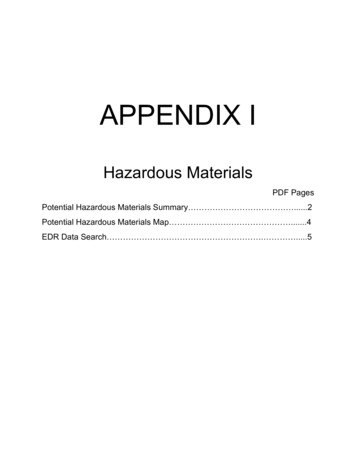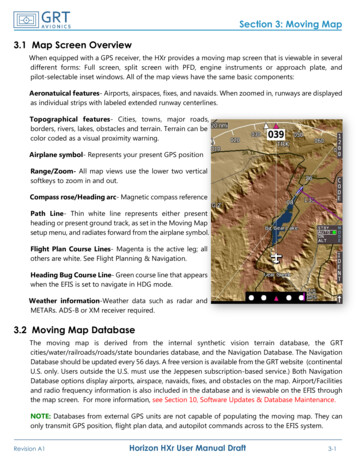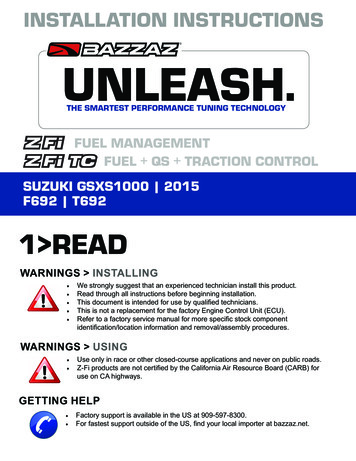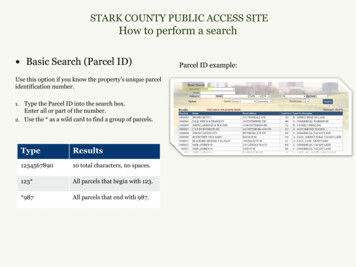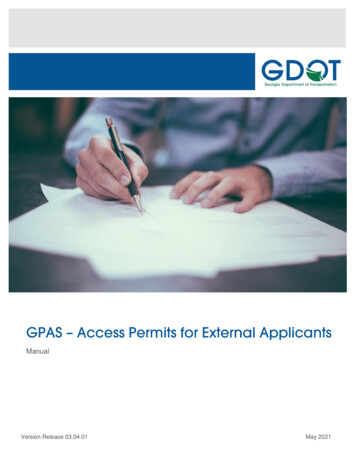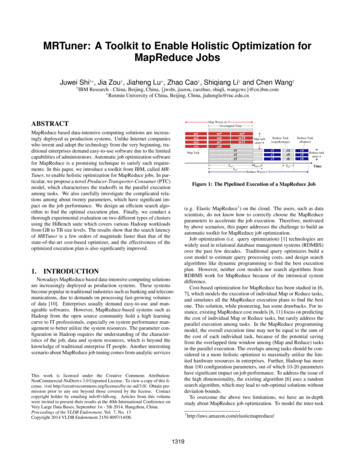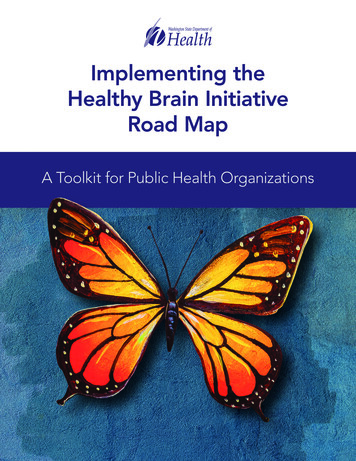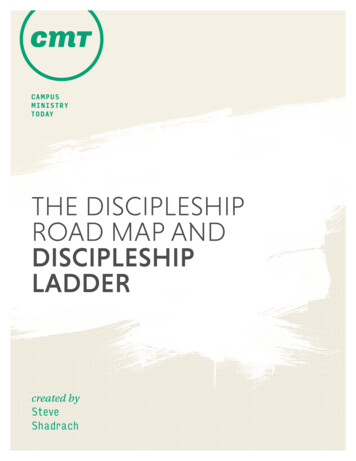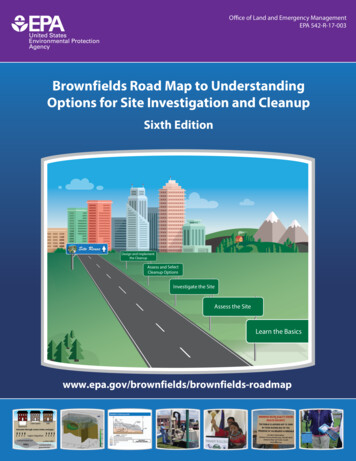
Transcription
Office of Land and Emergency ManagementEPA 542-R-17-003Brownfields Road Map to UnderstandingOptions for Site Investigation and CleanupSixth EditionSite ReuseDesign and Implementthe CleanupAssess and SelectCleanup OptionsInvestigate the SiteAssess the SiteLearn the Basicswww.epa.gov/brownfields/brownfields-roadmap
[This page is intentonally left blank]
Table of ContentsBrownfields Road MapTable of ContentsIntroduction . 1Follow the Brownfields Road Map . 6Learn the Basics . 9Assess the Site . 20Investigate the Site . 26Assess and Select Cleanup Options. 36Design and Implement the Cleanup . 43Spotlights1Innovations in Contracting . 182Supporting Tribal Revitalization . 193Project Life Cycle Conceptual Site Model . 254Vapor Intrusion . 345Mining Site Redevelopment. 356In Situ Technologies . 407Greener Cleanup Best Practices . 418Understanding the Role of Institutional Controls at Brownfields Sites . 429Optimization Best Practices for Challenging Cleanups . 4710Resilient Revitalization . 48AppendicesACSM and General Cleanup Steps. 49BList of Acronyms . 50CReferences and Additional Information . 52DGuide to Contaminants and Technologies . 56i
Brownfields Road MapThe Sixth Edition featuresthese updates: Additional details to assiststakeholders with planningtheir Brownfields projectsIntroductionThe Brownfields Road Map to Understanding Options for Site Investigation and Cleanup,Sixth Edition, provides a general outline of the steps in the investigation and cleanup ofBrownfields sites and introduces Brownfields stakeholders to the range of technologiesand resources available to them. The Road Map provides valuable information for General assistance fordeveloping each phase ofsite investigation andcleanupstakeholders typically involved in or affected by redevelopment of Brownfields sites, “Spotlights” on 10 currentissues and best managementpractices (BMPs)EPA Brownfields Program and an outline of the steps involved in the cleanup of a New and updated ASTMstandards Discussion of greenercleanup and resilientrevitalization best practiceswhether through public projects, private development or public-private partnerships.The first edition of the Road Map, published in 1997, provided a broad overview of theBrownfields site. Designed primarily for stakeholders who were unfamiliar with theelements of cleaning up a Brownfields site, the Road Map built awareness of theadvantages offered by innovative technologies. As the EPA Brownfields Programmatured, the second (1999), third (2001), and fourth (2005) editions were published toupdate information and resources associated with the program, innovativetechnologies, and emerging best practices. The fifth edition, published in 2012,streamlined the publication to make it more accessible to users, providing additionalresources covering new technology applications and methods.This edition builds off the streamlined approach of the fifth edition, providing updatedcontent and guidance on the Brownfields remediation process. New features include anupdated list of “Spotlights,” highlighting and describing key issues. This edition providesupdated information on Brownfields funding and best management practices (BMPs),with guidance on how to incorporate greener cleanups and new standards into thecleanup process.This edition of the Road Map will help: New and less experienced stakeholders. The Road Map will help these userslearn about the technical aspects of Brownfields by introducing generalconcepts and methods for site investigation and cleanup.1
Introduction Brownfields Road MapDecision-makers who are familiar with the EPA Brownfields Program but arealso interested in obtaining more detailed information. The Road Map providesthese users with up-to-date information about the applicability of technologiesand access to the latest resources that can assist them in making technologydecisions. In addition, it highlights BMPs that have emerged in recent years. Community members. The Road Map helps to encourage community membersto participate in the decision making process by providing information about thegeneral site cleanup process and tools and alternatives to site cleanup, as wellas guidelines and mechanisms to promote community involvement. Tribal leaders. The Road Map offers information on technical and financialassistance specific to tribes for implementing cleanup and restoration activitieson tribal lands, as well as successful remediation examples highlighting thepotential community restoration opportunities associated with Section 128(a)Response Program funding. Stakeholders who hire or oversee site cleanup professionals. The Road Mapincludes information to help stakeholders coordinate with many differentcleanup practitioners, such as environmental professionals, cleanup serviceproviders, technology vendors or staff of analytical laboratories. The Road Mapprovides these stakeholders with a detailed understanding of each phase in atypical Brownfields site cleanup and presents information about the roles thatenvironmental practitioners play in the process. Regulators. The Road Map will increase the understanding by regulatorypersonnel of site characterization and cleanup technologies and approaches.The Road Map also serves as a resource that regulators can use to provide siteowners, service providers and other stakeholders with useful information aboutthe EPA Brownfields Program. The Road Map also provides links and pointers toadditional information on specific technologies, approaches, and issues. Other potential Brownfields stakeholders. The Road Map helps otherstakeholders, such as financial institutions and insurance agencies, by providinginformation for their use in assessing and minimizing financial risks associatedwith Brownfields redevelopment.2
Brownfields Road MapIntroductionDisclaimerThe Road Map draws on the EPA’s experiences with Brownfields sites, as well asSuperfund sites, corrective action sites under the Resource Conservation and RecoveryAct (RCRA), and underground storage tank (UST) sites to provide technical informationuseful to Brownfield stakeholders. Specific conditions—such as the nature and extent ofcontamination, the proposed reuses of the property, the financial resources available,and the level of support from neighboring communities—vary from site to site. Readersof the Road Map are encouraged to explore opportunities to use the BMPs described inthe following pages in accordance with applicable regulatory program requirements.The use of BMPs and site characterization and cleanup technologies may require sitespecific decisions to be made with input from state, tribal, and/or local regulators andother oversight bodies.This document provides general information and guidance regarding facilitating reuse ofproperties. The information in this document is pertinent to sites that meet thedefinition of a Brownfield site and focuses on providing information to Brownfieldsstakeholders. Users of this document should determine whether their site meets thedefinition of a Brownfield site before using this document (the term "brownfield site"means real property, the expansion, redevelopment or reuse of which may becomplicated by the presence or potential presence of a hazardous substance, pollutantor contaminant). Sites that fall under other regulatory programs such as RCRA correctiveaction sites or Superfund sites are subject to the requirements of those programs. Whilesome of the information in this document may be helpful to them, they should relyprimarily on information sources focused on those types of sites.This document does not address all information, factors or considerations that may berelevant. This document is not legally binding. The word “should” and other similarterms used in this document are intended as general recommendations or suggestionsthat might be generally applicable or appropriate and should not be taken as providinglegal, technical, financial or other advice regarding a specific situation or set ofcircumstances. This document may be revised at any time without public notice. Anyreferences to private entities, products or services are strictly for informationalpurposes and do not constitute an endorsement of that entity, product or service.This document describes and summarizes statutory provisions, regulatory requirementsand policies. The document is not a substitute for these provisions, regulations orpolicies, nor is it a regulation or EPA guidance document itself. In the event of a conflictbetween the discussion in this document and any statute, regulation or policy, thisdocument would not be controlling and cannot be relied on to contradict or argueagainst any EPA position taken administratively or in court. It does not impose legally3
IntroductionBrownfields Road Mapbinding requirements on the EPA or the regulated community and might not apply to aparticular situation based on the specific circumstances. This document does not modifyor supersede any existing EPA guidance document or affect the Agency’s enforcementdiscretion in any way.About the EPA Brownfields ProgramBrownfields sites are defined as “real property, the expansion, redevelopmentor reuse of which may be complicated by the presence or potential presence ofa hazardous substance, pollutant or contaminant” (ComprehensiveEnvironmental Response, Compensation, and Liability Act of 1980, as amendedby the Small Business Liability Relief and Brownfields Revitalization Act of 2002,§101(39)). The cleanup of Brownfields sites improves and protects theenvironment and may result in many benefits for the local community.Summary of BrownfieldsProgram Accomplishmentsas of May 2017Thousands of properties have beenassessed and cleaned up with thesupport of grants and funding fromthe EPA Brownfields Program.MeasureCumulativeResultsProperties Assessed26,722The EPA established its Brownfields Economic Revitalization Initiative in 1995 toCleanups Completed117,000empower states, communities and other stakeholders in economic revitalizationDirect and IndirectJobs Created124,760Acres Made Readyfor Reuse67,419to work together to accomplish the redevelopment of Brownfields sites. Theenactment of the Small Business Liability Relief and Brownfields RevitalizationAct in 2002 expanded EPA assistance to provide greater support for Brownfieldscleanup and reuse. Many states and local jurisdictions also help communitiesadapt environmental cleanup programs to the special needs of alizing Brownfields sites has the potential to create benefits throughout thecommunity, including community involvement in the project, job creation, and anincrease in residential property values once a nearby Brownfields site is assessed orcleaned up.How to Submit CommentsHow to Obtain Additional CopiesThe EPA invites comments from members of theBrownfields community to help ensure that anyfuture versions of the Road Map meet their needs.Please submit comments to:A printed or hard copy version of this document can beobtained from the following source:Carlos PachonU.S. Environmental Protection AgencyOffice of Superfund Remediation andTechnology Innovationpachon.carlos@epa.gov(703) 603-9904National Service Center for Environmental PublicationsU.S. Environmental Protection AgencyP.O. Box 42419Cincinnati, OH 45242-0419Phone: (800) 490-9198Fax: (301) 604-3408Email: nscep@lmsolas.comWhen you order the Road Map, please refer to documentnumber 542-R-17-003.4
Brownfields Road MapIntroductionSmall Business Liability Relief and Brownfields Revitalization ActSince its inception in 1995, EPA's Brownfields Program has grown into a proven, results-oriented program that haschanged the way contaminated property is perceived, addressed and managed. EPA's Brownfields Program isdesigned to empower states, communities and other stakeholders in economic redevelopment to work together in atimely manner to prevent, assess, safely clean up and sustainably reuse brownfields.In January 2002, the Small Business Liability Relief and Brownfields Revitalization Act ("The Brownfields Law," PublicLaw 107-118; H.R. 2869) was signed. The Brownfields Law amended the Comprehensive Environmental Response,Compensation, and Liability Act (CERCLA or Superfund) by providing funds to assess and clean up Brownfields,clarified CERCLA liability protections and provided funds to enhance state and tribal response programs. Other relatedlaws and regulations impact Brownfields cleanup and reuse through financial incentives and regulatory requirements.Key changes to the EPA Brownfields program as a result of the Brownfields Law included:Improvements to EPA's existing Brownfields grants and technical assistance program by: Increasing available grant funding to approximately 100 million annually in recent years Providing grants for assessments, revolving loan funds, direct cleanups, area-wide planning andenvironmental workforce development and job training Expanding the entities, properties and activities eligible for Brownfields grants, including sites such as minescarred lands Expanding applicability to sites with petroleum contamination such as abandoned gasoline stations Providing authority for Brownfields training, research and technical assistance Allowing local government entities up to 10 percent of the grant funds to be used to monitor the health ofexposed populations and enforce any institutional controlsCreation of a strong, balanced relationship between the federal government and state and tribal programs that: Authorized up to 50 million per year for building and enhancing state and tribal response programs andexpanded the activities eligible for funding Provided protection from Superfund liability at sites cleaned up under a state or tribal program Preserved the federal safety net by detailing the circumstances in which the EPA can revisit a cleanup Clarified the state role in adding sites to the Superfund National Priorities List (NPL)Additional information on the Brownfields Law is available at tions.5
Follow the Brownfields Road MapThe Sixth Edition of the Road Map presents the general phases involved in theinvestigation and cleanup of a Brownfields site, introduces the reader to a range ofconsiderations and activities and provides links to online technical resources and tools.Overview of the Road MapThe Road Map follows the process illustrated in the Brownfields Road Map graphic (seepage 8). The first section, Introduction, discusses important factors that set the stage forthe investigation and cleanup of Brownfields sites. Sections 2 (Follow the Road Map)and 3 (Learn the Basics) introduce concepts, strategies and methods that can be appliedto efficiently and effectively prepare sites for reuse. The remaining sections correspondto the general phases of site characterization and cleanup, from site assessmentthrough implementation of cleanup remedies. The Road Map identifies examples ofregulatory considerations to take into account and discusses technologies within theoverall framework of site characterization and cleanup.Spotlights – The Road Map “spotlights” focus the reader’s attention on key issues,Brownfields Road MapUnderstanding the typicalprogression of the siteinvestigation and cleanupprocess ensures that theproper groundwork is laid forfuture phases.Site investigation and cleanuptypically do not occur in thelinear sequence outlined in theRoad Map. At many sites,several activities may beundertaken concurrently, whileothers recur throughout theprocess. Similarly, manytechnologies that are used tocharacterize sites during theinvestigation phase may alsobe used during the cleanupphase to monitor performanceand help reduce uncertaintiesrelated to site conditions.processes and initiatives. They provide a quick look at topics relevant to Brownfieldsprojects and identify how readers can obtain additional information.Appendices – Provided at the end of the Road Map document:Appendix A, CSM and General Cleanup Steps: A Crosswalk of Regulatory Program Stagesand Life Cycle Phases, is a crosswalk of specific terms used in different cleanup programsto identify cleanup stages. It puts these terms into the context of the Road Map.Appendix B, Acronyms, defines acronyms used in discussing and describing Brownfieldscleanup efforts.Appendix C, References and Additional Information, provides a list of references used todevelop the document and additional resources.6
Brownfields Road MapFollow the Brownfields Road MapAppendix D, Guide to Contaminants and Technologies, is a guide to contaminantscommonly found at types of Brownfields sites and the types of technologies that may beappropriate for their analysis and treatment.7
Brownfields Road MapBegin here to learn aboutfactors and considerations thataffect cleanup at a Brownfieldssite. These “basics” are integralto the cleanup process and theoverall success of theBrownfields project.General concepts and termsrelated to the investigation andcleanup of Brownfields sites areintroduced here and reinforcedthroughout the publication.Learn the BasicsBrownfields projects may be initiated for a number of reasons. A landowner may wantto sell a property to a prospective purchaser for development. A municipality may wantto clean up a parcel or area that has become a public hazard or eyesore, create spacefor business development or build a park. A local comprehensive plan may call for infilldevelopment of a certain type in a Brownfields area. In these cases, the Brownfieldsprocess will be tailored to the specific end use envisioned for the property re-purposing.Preparing a Brownfields site for reuse involves more than the investigation and cleanupof a property. The interests of many stakeholders must be integrated into the overallredevelopment process. Cleanup strategies vary from site to site, depending on factorsBrownfields Stakeholderssuch as intended end use, available funding, liability considerations, regulatoryA stakeholder is typicallyconsidered to be an individualwho can influence decisions oris impacted by decisionsregarding sites. Stakeholders forBrownfields projects mayinclude:requirements, the type and extent of contamination present and the technologies- Federal, state, tribal and localagencies- Local elected officials- Local and regional communitydevelopment agencies- Developers- Community members- Tribes- Property owners- Academia- Potentially responsible parties(PRPs)- Private business and industry- Non-profit organizationsprojects is to clean up sites in accordance with reuse goals and appropriate laws andavailable for cleanup. At some sites, cleanup will be completed before the propertiesare transferred to new owners. At other sites, cleanup may take place simultaneouslywith construction and redevelopment.Regardless of when and how cleanups are accomplished, a key challenge to Brownfieldsregulations, including changes which might occur during the cleanup process. It isessential that stakeholders become familiar with factors that play a significant role inthe success of a Brownfields project, such as understanding applicable regulations,engaging members of the community, identifying funding and obtaining professionalsupport.The Road Map outlines a general cleanup process and the names of the steps in thisprocess are specific to the cleanup of Brownfields sites. The overall process, however,applies to other cleanup programs as well. Refer to Appendix A (CSM and GeneralCleanup Steps: A Crosswalk of Regulatory Program Stages and CSM Life Cycle Phases) atthe end of this document for more information on other cleanup program steps andterminology.9
Learn the BasicsState Underground Storage Tank/Leaking Underground Storage Tank(UST-LUST) programs have tailored tools to meet site-specificinvestigation and cleanup needs. For more information, visit theapplicable state UST/LUST implementing agency ust-programs.Brownfields Road MapUnderstand Previous and Current PlanningActivities that Involve and Affect the SiteStakeholders should take into account howthe Brownfield site fits within the broaderplanning efforts for the community. Read the community’s master plan.What are its broad themes (make thecommunity more sustainable orresilient, increase economic growth,increase open space)? Determine how the Brownfield site cancontribute to one or more of thesethemes. Look at the zoning for the site. Whatuses are permitted? Would that zoningneed to be changed? Read the redevelopment plans for thearea. How can redevelopment of thesite contribute to them? Are there any market studies for thearea indicating the types of uses thatthe market would bear? Have there been other plans thatinvolved this site in the past? Whathappened? What lessons can belearned?Setting Reuse Goals and PlanningFrom the outset, it is important to consider potential reuse goals. Areuse plan based on those goals will govern most Brownfields projects,from identifying site investigation and cleanup standards that willprepare the site for the reuse plan, to obtaining competitive financingpotentially critical to the ultimate affordability of the project. Keep inmind, however, that new information about contamination or cleanupneeds may require that reuse plans be altered. Be prepared to develop aflexible project plan that will evolve as information is collected,community input is received and decisions are made about the cleanupapproach.Establishing reuse goals for a Brownfields project also helps the projectteam define the specific decisions to be made throughout the project.This is fundamental to selecting appropriate technologies for siteinvestigation and cleanup which enable those responsible for theBrownfields project to collect the data necessary to support thosedecisions and accomplish the established goals.With this information, stakeholders cancreate a planning framework for the site.The most efficient way to use resources is to identify a redevelopmentgoal at the beginning of the project. If reuse goals are not known fromthe outset, Brownfield funds can best be harnessed by establishing aState and Tribal Response Programsclear redevelopment objective. The stakeholders should at a minimumState and Tribal response programs—toprovide liability clarity or support cleanupat specific sites—continue to be at theforefront of Brownfields cleanup andredevelopment.make every attempt to identify the general type of desired development,whether open space/recreational, industrial, commercial, residential ormixed-use. Without that information, the most conservative assumptionsmight be applied at every stage of the Brownfields project. While this canprovide greater flexibility later in the redevelopment process, it can alsosignificantly increase the time and expense of the project.State and Tribal Response ProgramHighlights describe recent progress thestates and tribes are making to addresscontaminated land in their communities.Further information is available in Spotlight2 and online ld-response-programs10
Brownfields Road MapLearn the BasicsUnderstanding Regulations, Regulatory Guidelines and Liability ConcernsThe redevelopment of Brownfields sites may be subject to various federal, state, tribaland local laws, regulations, policies and guidelines with respect to the characterizationand cleanup of the site. The standard practices of other government, nongovernmentand private institutions may also govern these sites.The applicable laws, regulations, policies and guidelines will vary by site,Example of Regulatory RequirementIf the proposed end use for a Brownfieldssite calls for construction of a lightindustrial facility, it may be appropriate,depending on state and local regulatoryrequirements, to compare the relevantcleanup standards for industrial as well ascommercial or residential reuse standards.If the more stringent standard required forcommercial or residential reuse is used,additional cleanup and costs may berequired initially, but doing so providesgreater flexibility and avoids future delaysif the proposed reuse is likely to change.The required standards need to beconsidered throughout the project.depending on the regulatory authorities that have oversight authority forcleanup. Therefore, it is important to research this information at the outsetand to work closely with the regulatory authorities throughout the cleanupprocess. For example, state, tribal or local regulatory authorities usuallyoversee the cleanup of Brownfields sites. These agencies should be consultedto determine what, if any, site-specific requirements, reviews, approvals orpermits are applicable.At the EPA, the Office of Site Remediation Enforcement (OSRE) supportscleanup and revitalization by issuing enforcement discretion guidancedocuments, model enforcement documents, responses to frequently askedquestions, fact sheets and other documents. OSRE works with the EPA regionaloffices to provide guidance on relevant enforcement tools to potentialdevelopers and owners of contaminated land. These documents, along with currentSuperfund enforcement and Brownfields policy and guidance documents, are availableon the EPA’s website at lization-cleanup-enforcement. The EPA also can be a valuable resource forBrownfields stakeholders by providing regulatory and policy support to facilitate theselection of technologies.Many of the standard practices are designed to help Brownfields redevelopmentprojects obtain financing from public programs and private banks and institutions.Guidance and standards are issued by government and nongovernment organizations,such as ASTM International (formerly the American Society for Testing and Materials),the Federal Deposit Insurance Corporation (FDIC), state, tribal and local economicdevelopment authorities and private lenders.Subsequent sections of this Road Map identify regulatory considerations at relevantphases of investigation and cleanup. Stakeholders are encouraged to regularly consultwith appropriate regulatory agencies to ensure that requirements are properlyaddressed throughout the project.11
Learn the BasicsBrownfields Road MapEngaging the CommunityEncouraging active participation by members of the community whoare most likely to be affected by site cleanup and reuse planscontributes to the success of the project. Engage the community toraise awareness, identify community concerns and build support forcleanup efforts that will lead to redevelopment and revitalization oftheir community. To maximize chances for success, plan early forhow the community stakeholders will be identified and encouragedto participate for the duration of the Brownfields project, from theinvestigation phases through cleanup.It is important that Brownfields decision-makers encourageacceptance of reuse plans and cleanup alternatives by involvingKey Resource for Community EngagementEPA’s Brownfields Program is designed topromote the active participation of communitiesin each phase of the cleanup process so thatrevitalized land offers the greatest local benefit.The Brownfields Stakeholder Forum Kit is a guideto assist communities in planning effectivestakeholder forums by providing tools and tipsfor engaging stakeholders and establishingpartnerships to address revitalizationchallenges. The kit is available orum-kit.members of the community through multiple outreach methodssuch as public meetings, newsletters, publications, websites andsocial networks. For an individual site, consider how the people livingin or near the site might be affected by cleanup activities and theintended reuse of the property; plan early and appropriately for howcleanup decisions and their potential impact will be shared with thecommunity. For example, the community should be informed abouthow the use of a proposed technology might affect redevelopmentplans or the adjacent neighborhood.Key Resource for Regulatoryand Liability ConcernsThe Revitalization Handbook, updated
Brownfields Road Map to Understanding Options for Site Investigation and Cleanup, Sixth Edition, provides a general outline of the steps in the investigation and cleanup of Brownfields sites and introduces Brownfields stakeholders to the range of technologies and resources available to them. The Road Map provides valuable information for
